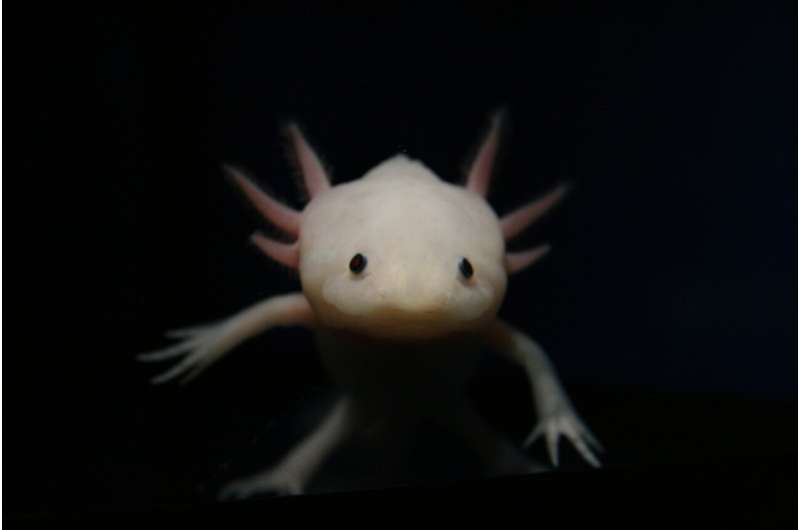This article has been reviewed according to Science X's editorial process and policies. Editors have highlighted the following attributes while ensuring the content's credibility:
fact-checked
peer-reviewed publication
trusted source
proofread
Decoding the axolotl: A new path for limb regrowth

In a new study published in Nature Communications, EPFL researchers shed light on the axolotl's unparalleled limb regeneration abilities, challenging long-held beliefs and offering new insights into potential mammalian limb regrowth.
In the serene waters of Mexico, the axolotl—a type of salamander—has long fascinated scientists with its remarkable ability to regrow lost limbs. This intriguing capability has made it a focal point for researchers trying to unlock the secrets of limb regeneration. Nonetheless, the regenerative ability of the axolotl has proven elusive, generating no small amount of controversy.
The key player is a structure known as the "apical-ectodermal-ridge" (AER), which play a pivotal role in the development of limbs in vertebrates. In the developing embryo, the AER forms out of the so-called limb bud, and becomes the main signaling center that organizes and ensures that the new organism's limbs will grow properly. Without an AER, no limb should be formed.
What does this have to do with the axolotl? Multiple studies trying to understand how the axolotl regenerates its limbs have not been able to determine if these animals use or even has AER cells. The importance of this cannot be understated, given that these cells are shared by multiple species and considered to be requirement for successful limb development, including humans.
Now, scientists at EPFL and TU Dresden have finally unlocked the mechanism of the axolotl's limb regrowth, offering fresh insights with huge implications for regenerative medicine in humans. The study was led by the group of Can Aztekin, who is an Early Independent Research Scholar (ELISIR) and a Branco Weiss Fellow at EPFL's School of Life Sciences, with a collaboration with Tatiana Sandoval-Guzmán's group at TU Dresden.
Single-cell transcriptomics: A multi-species atlas
The researchers began by creating an "atlas"—a high-level dataset—of the transcriptome of single cells from multiple species, including the axolotl, humans, mice, chickens, and frogs. The transcriptome represents a comprehensive set of RNA transcripts produced by a cell's genome.
"Leveraging an unprecedented atlas and comparing thousands of individual cells across five species, including humans and axolotls, our strategy gave us a unique chance to determine the axolotl's unique cellular landscape during limb regrowth as well as how similar these animals are to humans in an unbiased manner," says Can Aztekin.
The purpose of the atlas was to make detailed comparisons between the gene-expression profiles of the different species during limb development and regeneration, and determine which genes are involved and which are not.
The deep dive yielded treasure: Axolotls have cells with characteristics very similar to AER cells. "Despite previous conflicting reports, our work shows that these creatures contain cells with characteristics similar to those essential in arm or leg development in other species, including humans," says Jixing Zhong, the first author of the paper who is a Ph.D. student in the Aztekin Lab.
Opening new ways to limb regrowth
But there was a twist to the study, one that challenges long-held assumptions about limb regeneration. The researchers used an approach called "spatial transcriptomics", a cutting-edge technique that can reveal which genes are being expressed in specific parts of a tissue.
The approach revealed that axolotl limbs do not fully reform AER cells during regeneration. Aztekin explains, "During regeneration in the axolotl, the AER-like cells do not completely reform in the way many had assumed—even countering the dogma in our commonly used textbooks—unveiling a unique approach to limb regrowth in axolotls."
The study showed that the axolotl uses parts of the fundamental limb-development AER program—like other species—but it is split across different cell types. Aside from challenging previously held assumptions about limb regeneration and developmental biology, the discovery makes it possible to now explore multiple strategies for limb regeneration in mammals, including humans.
"While it was previously thought that there was a universal method to limb regeneration, our findings indicate a more complex reality," says Zhong. Aztekin continues, "Studying the regenerative capabilities of axolotls and frog tadpoles, evolutionarily the closest species to humans with limb regeneration abilities, we discovered that these species use different cell types during the regeneration process, suggesting that there might be multiple ways to achieve limb regeneration."
More information: Jixing Zhong et al, Multi-species atlas resolves an axolotl limb development and regeneration paradox, Nature Communications (2023). DOI: 10.1038/s41467-023-41944-w
Journal information: Nature Communications
Provided by Ecole Polytechnique Federale de Lausanne




















